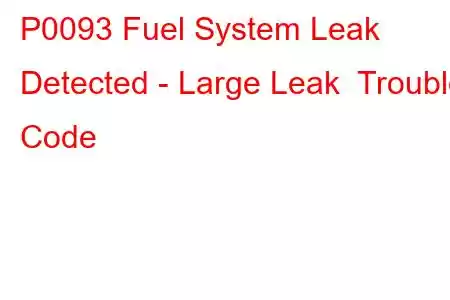P0093 Fuel System Large Leak Detected
OBD-II Trouble Code Technical Description
Fuel System Large Leak Detected
What does that mean?
This diagnostic trouble code (DTC) is a generic powertrain code. It is considered generic because it applies to all makes and models of vehicles (1996-newer), although specific repair steps may be slightly different depending on the model.
When the computer sets this code it senses a large fuel leak in the high pressure section of the engine. The ECM in a diesel always monitors and controls the fuel pressure from the fuel injector pump to the injectors as long as the engine is running.
To set a code P0093 the ECM must sense a sudden large drop in fuel pressure within the system. This drop in fuel pressure can be internal, external or caused by a faulty sensor signal to the ECM.
When this happens, the ECM sets the code, goes into fail-safe mode which will suspend the fuel injector pump operation and allow one minute to pull over before it shuts the engine down. It will remain in fail-safe mode until the key is off.
The engine may run again but investigate the problem first. This problem will not correct itself or go away. The engine could shut down at any time or speed.
Unlike gasoline engines with fuel injection pressures of 30 to 50 PSI, diesel engine fuel pressure runs up in the Megapascal range, from 4,500 to 30,000 PSI. It takes very high fuel pressure to force fuel into the high compression cylinder of a diesel.
As you progress in diagnosing the problem be always mindful of the fuel pressure when the engine is running. It is ridiculously high! You have a code P0093 stating there is a large fuel leak in the system. Use caution when sticking your nose under the hood of a running engine with this code, or wrenching on the fuel system.
Symptoms
Symptoms of a P0093 diagnostic trouble code may include:
Code set and malfunction indicator lamp illumination (check engine light) Engine will enter fail-safe mode and shut down within one minute Possible large loss of power above idleCauses
Potential causes for this DTC include:
Fuel injector failure Fuel line common rail leak Fuel pressure sensor malfunction Fuel pump or lift pump failure Fuel heater constantly on Fuel temperature sensor failure Leaks at any point in the high pressure circuit Electrical connector corrosion or seating problems Fuel pressure regulator malfunction Fuel filter plugged dropping the fuel line volume Injector pump leak Fuel control actuator failure Cascade overflow valve malfunction Short in the electrical harness at the injectors or to the ECM Fuel pressure limiting valve ECM failureDiagnostic Steps & Possible Solutions
Start with the engine off and doing a walkaround inspection for obvious fuel leaks between the fuel tank and the engine. Lift the hood and check the oil and level. If the oil level has risen, smell the oil. If it is heavily contaminated by fuel, an injector most likely failed in the open position. Do not start the engine again until the oil and filter is changed. Look under the hood for leaks. Start at the injector pump and follow the fuel lines to the fuel injector rail. Look at the injectors for signs of leaks. Pull the electrical connector off the fuel pressure sensor and look for fuel in the connector. A failed sensor will allow fuel up through the sensor into the connector. Check when you last changed the fuel filter. A plugged fuel filter will drop the volume enough to set the code. Check all electrical connectors on the sensors and wiring harness to the injectors for missing insulation, corrosion or loose connections. If no obvious leaks have been found, go online and look up the TSBs (technical service bulletins) for your year and make vehicle. Diesels have no lack of problems as the TSBs will indicate.Look for the code and associated repair pr
Read: 51


